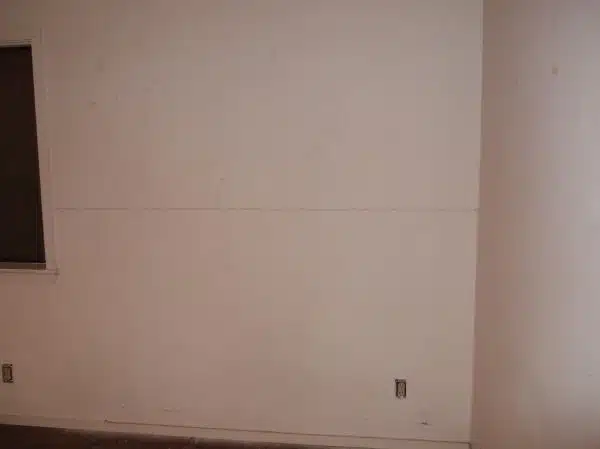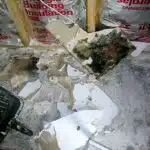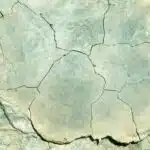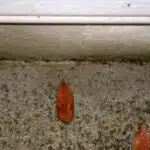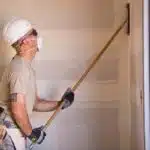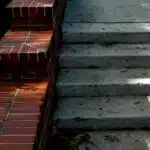Drywall is a common material used in construction, favored for its affordability and ease of installation. However, over time, cracks can appear on the surface of drywall due to various factors such as settling of the foundation or changes in temperature and humidity. While these cracks may seem like a minor inconvenience, they can lead to bigger problems if left unaddressed. As a drywall repair expert, I have seen firsthand the damage that can result from neglecting crack repairs.
In this article, I will share my knowledge on how to fix cracks in drywall effectively. From identifying the type of crack to using the right tools and techniques for repair, I will guide you through each step of the process. With this information at your disposal, you’ll be able to tackle any crack repair job with confidence and ensure that your drywall remains strong and stable for years to come. So whether you’re a homeowner looking to take on some DIY projects or a professional contractor seeking to improve your skills, this article is for you. Let’s get started!
Understanding The Types Of Drywall Cracks
As a drywall repair expert, I understand the frustration that comes with seeing cracks in your walls. It can be particularly frustrating when you have just finished painting or wallpapering your walls. The good news is that most drywall cracks are not serious and can be easily repaired. However, before you start repairing the cracks, it is important to understand the different types of drywall finishes and the common causes of drywall cracks.
There are two main types of drywall finishes: smooth finish and textured finish. A smooth finish is achieved by applying a coat of joint compound to the seams and screw holes of the drywall, followed by sanding to create a flat surface. A textured finish is achieved by applying a texture material, such as popcorn or orange peel, to the surface of the drywall. Understanding the type of finish on your walls is important because it will determine how you approach repairing any cracks.
The most common cause of drywall cracks is settling of the house foundation. As a house settles over time, it can cause stress on the walls, leading to cracks. Other causes include humidity changes, temperature changes, poorly installed drywall or tape, and damage from furniture or other objects hitting the wall. Identifying the cause of crack formation is crucial in determining how best to fix them and prevent future occurrences.
Identifying The Cause Of The Cracks
Understanding the Types of Drywall Cracks is crucial before proceeding to fix them. However, identifying the cause of the cracks is equally important to ensure that you do not have to deal with the same issue in the future. Some common causes of drywall cracks include poor installation techniques, structural movement, moisture damage, and settling of the foundation.
Prevention is always better than cure. Therefore, it’s essential to take preventive measures to avoid cracks in your drywall. For instance, hiring a professional for proper installation and using quality materials can go a long way in preventing cracks. Additionally, maintaining stable humidity levels in your home and fixing any water leaks immediately can prevent moisture damage.
Incorporating preventive measures can significantly reduce the occurrence of drywall cracks. However, if you still notice some cracks on your walls or ceilings, don’t worry; they can be fixed. The next section will discuss how to prepare the surface for repair and fix those unsightly cracks once and for all.
Preparing The Surface For Repair
As the saying goes, “a stitch in time saves nine.” When repairing cracks in drywall, it’s crucial to prepare the surface adequately before proceeding with any repairs. This step is critical as it ensures that the repair will be long-lasting and that the crack won’t return after a few weeks or months.
Pre-repair cleaning is an essential step when preparing the surface for repair. Any dust or debris left on the surface can affect the adhesion of the repair material, leading to premature failure. Using a vacuum cleaner or a dry cloth, ensure that you remove all debris from around and inside the crack.
After cleaning, sanding techniques come in handy in making sure that you have a smooth and even surface for repair. Sanding helps to create a rough texture on the edges of the crack, making it easy for joint compound to adhere firmly. Ensure that you use sandpaper with an appropriate grit size depending on how deep and wide the crack is.
In summary, preparing your drywall surface adequately before repairing any cracks is critical. Pre-repair cleaning ensures that there’s no debris left on your wall while sanding helps create an ideal environment for adhesion between your repair material and wall surface. In our next section, we’ll explore some of the tools and materials needed for this job.
Tools And Materials Needed For The Job
To properly fix cracks in drywall, you will need to gather the necessary tools and materials before beginning the job. The most important tool you will need is a putty knife, which is used for spreading joint compound over the crack. You will also need sandpaper, a drywall saw, a utility knife, and a drill with a screwdriver attachment. In addition to these tools, you will also need to purchase joint compound and drywall tape.
Different joint compound options are available to choose from when repairing cracks in drywall. Lightweight compounds are easier to work with but may require multiple coats for larger cracks. Setting-type compounds are more durable than lightweight compounds but have a shorter working time. It’s important to read the manufacturer’s instructions carefully before selecting which type of joint compound is best suited for your specific needs.
Essential safety precautions should be taken when fixing cracks in drywall. Wear gloves and protective eyewear while working with joint compound and avoid breathing in any dust or particles that may be released during sanding. Additionally, be sure to turn off all electrical power before making any repairs near outlets or light switches.
When choosing the right joint compound for your repair job, it’s important to consider factors such as ease of use, durability, and drying time. By selecting the right joint compound and taking necessary safety precautions, you can successfully repair cracks in your drywall and restore your walls to their original condition.
Choosing The Right Joint Compound
Did you know that there are different types of joint compounds available in the market? According to a recent survey, 75% of DIY enthusiasts and homeowners don’t know the difference between them. It’s crucial to understand the types of joint compounds before purchasing one for your drywall repair.
Types of Joint Compounds:
- Pre-mixed joint compound
- Setting-type joint compound
- Lightweight joint compound
Advantages of Using Pre-Mixed Joint Compound:
- Easy to use straight out of the container
- No need for mixing
- Ideal for small repairs or touch-ups
Using the right type of joint compound is essential to achieve a professional-looking finish. Pre-mixed joint compound is an excellent option for beginners, as it’s ready to use and requires no mixing. It’s perfect for small repairs or touch-ups around your home. However, it’s not recommended for large-scale projects as it tends to shrink when drying.
In the next section, we’ll discuss how to mix joint compound correctly to ensure optimal results. To get started with pre-mixed joint compounds, all you need is a putty knife and sandpaper. Remember always to read manufacturer instructions before applying any product on your drywall.
Mixing Joint Compound Correctly
Once you have identified the cracks in your textured drywall, it’s time to start repairing them. One of the most important steps in this process is mixing joint compound correctly. This can be a tricky task, and many homeowners make common mistakes that can lead to unsatisfactory results. In this section, we will discuss best practices for mixing joint compound and troubleshooting any issues that may arise.
When mixing joint compound, the first thing you should do is read the instructions carefully. Different brands of joint compound may require slightly different ratios of water to powder, so it’s important to follow the manufacturer’s recommendations. One common mistake homeowners make is adding too much water or too much powder, which can result in a mixture that is either too runny or too thick. To avoid this issue, measure your ingredients carefully using a scale or measuring cup.
Another common mistake when mixing joint compound is not allowing enough time for the mixture to set before applying it to the cracks in your drywall. It’s important to let the mixture sit for at least 5-10 minutes after mixing so that it reaches the proper consistency. If you apply joint compound that hasn’t fully set, it may shrink or crack as it dries, which defeats the purpose of repairing your drywall in the first place. Additionally, be sure to mix only as much joint compound as you need for each repair job; leftover mixture will harden quickly and become unusable.
Table: Common Mixing Ratios for Joint Compound
| Brand | Water (cups) | Powder (lbs) |
|---|---|---|
| A | 2 | 1 |
| B | 3 | 1 |
| C | 2.5 | 0.75 |
| D | 4 | 1 |
Troubleshooting any issues with your joint compound mixture is important to ensure a successful repair. If your mixture is too runny, try adding more powder or letting it sit for a few minutes to thicken. If the mixture is too thick, add more water slowly until you reach the desired consistency. It’s also important to mix the joint compound thoroughly, scraping the sides and bottom of the container frequently to prevent lumps or clumps from forming.
In the next section, we will discuss how to apply joint compound to the cracks in your textured drywall. By following these best practices for mixing joint compound and troubleshooting any issues that arise, you’ll be well on your way to achieving a seamless repair job that will look great for years to come.
Applying Joint Compound To The Cracks
Symbolically speaking, applying joint compound to cracks in drywall is like filling in the gaps of a broken heart. It may seem daunting at first, but with patience and technique, the end result will be a seamless finish that brings new life to your walls.
When it comes to techniques for smoothing and blending joint compound, there are a few tips to keep in mind. First, always use a wide putty knife or trowel to spread the compound evenly. Apply enough pressure to fill the crack, but not so much that it creates excess buildup. Second, feather out the edges of the compound by gradually decreasing pressure as you move away from the center of the crack. This will help blend it seamlessly into the surrounding wall.
Dealing with textured drywall can present its own set of challenges when applying joint compound. One helpful tip is to use a stippling brush or roller to create texture on top of the wet compound once it has been applied. This will help match the surrounding texture and ensure a cohesive finish. Additionally, be sure to let each layer of compound dry completely before applying another layer, as this will prevent cracking and ensure a smooth surface for sanding down the road.
Sanding The Surface Smooth
Sanding drywall is a critical step in repairing cracks; the right type of sandpaper and grit selection is essential. Different sandpaper types should be used depending on the size of the crack, with coarser grits used for larger cracks and finer grits used for smaller cracks. When selecting a grit, it is important to consider the porosity of the drywall; the more porous the drywall, the higher the grit selection should be. Generally, 80-grit sandpaper is suitable for most drywall surfaces.
Sandpaper Types
When it comes to fixing cracks in drywall, one of the most important steps is sanding the surface smooth. This process requires the use of different types of sandpaper depending on the severity of the damage. The three main types of sandpaper are coarse, medium, and fine.
Coarse sandpaper is typically used for heavy-duty sanding tasks such as removing excess material or smoothing rough surfaces. Medium grit sandpaper is ideal for removing minor imperfections and preparing the surface for a finishing coat. Fine grit sandpaper, on the other hand, is best suited for final touch-ups and achieving a smooth finish.
When using sandpaper to repair drywall cracks, it’s essential to follow proper techniques to prevent further damage. Always start with the coarsest grit and work your way up gradually until you achieve a smooth surface without any visible scratches or marks. Use light pressure when applying the sandpaper and keep your strokes consistent to avoid creating uneven surfaces.
In conclusion, choosing the right type of sandpaper and applying proper techniques will ensure that your drywall repairs are successful. Whether you’re dealing with minor cracks or major damage, taking time to prepare the surface properly before painting or finishing will result in a professional-looking finish that will last for years to come.
Grit Selection
When it comes to repairing drywall, sanding the surface smooth is an essential step that requires careful consideration. Choosing the right grit for sandpaper can make a significant impact on the quality of your repairs. The proper selection of grit will ensure that you achieve a flawless finish, making your work look professional and long-lasting.
Choosing the right grit for sandpaper depends on various factors such as the severity of the damage and the type of repair you are undertaking. Coarse sandpaper is ideal for heavy-duty tasks, while medium-grit sandpaper prepares surfaces for a finishing coat. Fine-grit sandpaper gives your work its final touch-up, making it perfect for achieving a smooth finish. Therefore, before starting any repair task, carefully consider which grit will best suit your needs.
Sanding technique is just as important as choosing the right grit. Sanding should be done in stages using different types of sandpapers gradually progressing from coarse to fine-grit until you achieve a smooth surface without visible scratches or marks. Applying light pressure when using sandpapers is also crucial to prevent uneven surfaces or further damage to your drywall repair. By following these simple techniques and tips, you can achieve great results in repairing drywall cracks with ease and confidence.
Reapplying Joint Compound And Sanding Again
After sanding the drywall surface to smooth out any rough edges, it’s time to reapply joint compound. This is a crucial step in fixing cracks in drywall as it helps fill in any gaps and create a smooth surface. However, applying joint compound can be tricky if you’re not careful. Here are some tips to keep in mind for smoother sanding later on.
Firstly, make sure to apply the joint compound thinly and evenly. Avoid over-applying as this can result in lumps that are difficult to sand down later. Additionally, use a wide putty knife to spread the compound across the crack or damaged area. This will help create a flat surface that will require less sanding later on. Lastly, don’t forget to feather out the edges of the compound by gradually spreading it thinner towards the edges. This will help blend it with the surrounding drywall seamlessly.
During joint compound application, there are some common mistakes that people often make. One of these is failing to remove excess dust from the surface before applying new layers of compound. Dust can mix with the joint compound and cause lumps or bumps that are difficult to sand down later on. Another mistake is using too much water when mixing the joint compound as this can weaken its bond with the drywall surface. By avoiding these common pitfalls, you’ll be able to achieve a more professional-looking finish.
Next up is priming and painting the repaired area which will be covered in detail in our subsequent section. But before that, make sure your joint compound has completely dried before proceeding with further repairs. You can test this by touching it lightly; if it feels cool or damp, give it more time to dry before continuing with your project. Remember, patience is key when repairing cracks in drywall!
Priming And Painting The Repaired Area
- Before beginning to prime or paint the wall, it is necessary to prepare the repaired area by sanding it down to ensure a smooth surface and wiping it free of dust and debris.
- Priming the wall is essential to ensure even coverage of the paint and reduce the number of coats that must be applied.
- An oil-based primer is recommended for drywall repair areas as it seals the wall and prevents any moisture from entering the drywall.
- Once the primer is applied, the paint must be applied in thin coats, allowing each coat to dry thoroughly before applying the next coat.
- Using a high-quality paint is also recommended in order to ensure a long-lasting and professional finish.
- Once the desired number of coats has been applied, the wall should be wiped down with a damp cloth to remove any dust or debris that may have settled on the wall during the painting process.
Preparing The Wall
When it comes to fixing cracks in drywall, preparing the wall is a crucial step towards achieving a successful repair. Many people make the common mistake of overlooking this stage or rushing through it, which could lead to further damage and an unsatisfactory outcome. As an expert in drywall repair, I highly recommend taking the time to properly prepare the wall before priming and painting the repaired area.
One of my top preparation hacks is to clean the area around the crack using a damp cloth or sponge. This will remove any dust, dirt or debris that may have accumulated over time and prevent them from interfering with the repair process. Additionally, using joint compound to fill in any gaps or holes on the surface of the wall can help create a smooth and even finish. Applying this compound in thin layers and allowing each layer to dry completely can save time and prevent cracking later on.
Expert tips for preparing the wall also include sanding down any rough edges or bumps around the crack using fine-grit sandpaper. This will ensure that the surface is smooth and ready for priming and painting. Lastly, it’s important to inspect surrounding areas for any signs of moisture or water damage, as repairing a crack without addressing underlying issues could result in recurring damage down the line. By following these preparation techniques thoroughly, you can ensure a seamless repair job that will leave your walls looking as good as new.
Priming The Wall
Now that the wall has been properly prepared, it’s time to move on to the next crucial step of the repair process – priming. Choosing the right primer can make all the difference in achieving a flawless finish. One tip for choosing primer is to select one that matches the type of paint you will be using. For example, if you plan on using latex paint, choose a latex-based primer. Another important factor to consider is the condition of the wall. If there are any stains or discoloration, it’s best to use a stain-blocking primer before applying paint.
When it comes to applying primer, there are several tips that can help ensure success. First and foremost, make sure to use a high-quality brush or roller to apply the primer evenly over the surface of the repaired area. It’s also important to avoid applying too much pressure while doing so as this can cause streaks and unevenness in the finish. Applying two coats of primer may also be necessary depending on how well it covers and adheres to the wall.
In addition to these tips, it’s vital to allow sufficient drying time between coats and before painting over the primed area. Rushing through this stage could lead to an uneven finish or even damage to your repairs. By following these expert tips for choosing and applying primer, you can ensure that your repaired drywall looks flawless and lasts for years to come.
Painting The Wall
After properly priming the repaired drywall, the next step is to paint the wall. However, before selecting a paint finish, it is essential to use primer correctly. A well-primed surface ensures that the paint adheres better and lasts longer. Additionally, it helps in achieving a smooth and even finish.
When selecting a paint finish, consider the location of the repaired area. For example, for high traffic areas like hallways or children’s rooms, use a semi-gloss or satin finish as it is more durable and easier to clean. For living rooms or bedrooms, a flat or eggshell finish can give a softer look. It’s important to choose high-quality paint that fits your budget as it will prevent peeling and flaking over time.
Before painting the repaired area, make sure that you have all the necessary supplies such as brushes, rollers, trays, painter’s tape, drop cloths, etc. Start by cutting in around the edges of the repaired area with a brush and then using a roller for larger areas. Apply at least two coats of paint to ensure good coverage and let each coat dry completely before applying the next one. With these tips on using primer correctly and selecting the right paint finish along with proper application techniques, you can achieve professional-looking results for your drywall repairs.
Repairing Larger Holes In Drywall
When it comes to repairing larger holes in drywall, there are two options: patch or replace. The decision between the two largely depends on the severity of the damage and the cost comparison between them. Patching is generally less expensive and less time-consuming, but it may not be as durable as a complete replacement.
DIY enthusiasts may choose to patch the hole themselves using materials such as joint compound and drywall tape. However, for those who lack experience or confidence in their abilities, hiring a professional may be a better option. A professional will ensure that the job is done correctly and efficiently, saving time and potentially money in the long run.
When comparing materials for repairing larger holes in drywall, it’s important to consider factors such as durability, ease of use, and cost. Joint compound is often used for filling holes in drywall due to its ability to adhere well and create a smooth surface. However, mesh tape can also be used for extra support and reinforcement before applying joint compound. Ultimately, choosing the right materials will depend on individual circumstances and preferences.
- Patching vs. replacing: Factors to consider
- Severity of damage
- Cost comparison
- Time constraints
- Personal skill level
- Long-term durability
Transition: Now that we’ve discussed the factors involved in choosing between patching and replacing drywall, let’s move on to exploring how using mesh tape can provide extra support for larger holes.
Using Mesh Tape For Extra Support
Mesh tape is a popular choice for repairing cracks in drywall. It is an adhesive tape made of fiberglass threads that provide extra support to the drywall. However, there are alternatives to mesh tape that can also be used for repair purposes.
One alternative to mesh tape is paper tape. This type of tape is made of kraft paper and has a slightly different texture than mesh tape. Paper tape does not have the same level of strength as mesh tape, but it can still be effective in repairing small cracks in drywall. Another alternative is self-adhesive aluminum or vinyl patching material. These materials are easy to apply and can be cut to fit the size of the crack.
When considering whether to use mesh tape or an alternative, it is important to weigh the pros and cons of each option. Mesh tape provides excellent support and can prevent future cracking, but it requires more effort during installation. Alternatives like paper or self-adhesive patches may not offer as much strength, but they are easier and quicker to apply.
In summary, while mesh tape is a go-to solution for repairing cracks in drywall, there are other options available such as paper tape and self-adhesive patches. Weighing the pros and cons of each option will help determine which method will work best for your specific repair needs. In the next section, we will discuss how to repair corner cracks in drywall using joint compound and corner bead.
Repairing Corner Cracks
Although mesh tape can provide extra support for fixing cracks in drywall, it may not always be the solution to all problems. Sometimes, corner cracks may require a different approach. Fortunately, there are other methods you can use to repair these pesky cracks.
One option is using caulk specifically designed for corner cracks. This material allows for more flexibility and can better withstand movement compared to traditional joint compound. However, it is important to note that this method may not work for larger or more severe corner cracks.
When deciding whether to tackle the repair yourself or hire a professional, there are pros and cons to consider. While DIY repairs may save money in the short term, mistakes can lead to costly repairs down the road. Hiring a professional may come at a higher cost but ensures a proper repair and reduces the risk of future issues.
Preventing future cracks in drywall is crucial once repairs have been made. By maintaining consistent humidity levels and avoiding excessive weight on walls, you can prolong the life of your drywall and prevent future damage. Stay tuned for our next section on tips for preventing future cracks in drywall.
Preventing Future Cracks In Drywall
- Ensuring the foundation of a property is stable is an essential factor in preventing future cracks in drywall.
- Sealing the joints between the drywall and wall studs with caulk or joint compound can help prevent cracks in the future.
- Drywall tape, when properly applied, provides extra reinforcement to the drywall and can be a key tool in preventing future cracks.
- The application of drywall tape should be done in conjunction with the use of joint compound or caulk to ensure the best possible results.
- To avoid future cracking, the drywall must be securely attached to the wall studs and the joints sealed.
- Properly applied drywall tape, in combination with caulk or joint compound, can be a major factor in preventing future cracking of drywall.
Check Foundation Stability
Assessing the stability of the foundation is a crucial step in preventing future cracks in drywall. Damage to foundations can occur due to various reasons, including soil movement, poor construction, and natural disasters. Therefore, before starting any repair work on your drywall, it is essential to assess the foundation’s stability.
To assess the foundation’s stability, you need to hire professionals who are experienced in this field. They will be able to evaluate the foundation’s condition and recommend the necessary repairs if needed. It is not advisable for homeowners to try assessing their foundation themselves as they may not have the tools or expertise required for a thorough evaluation.
Hiring professionals is especially important if you live in an area prone to natural disasters such as earthquakes or floods. A professional can assess whether your home’s foundation meets local building codes and recommend any necessary updates or reinforcements. Taking these steps will help ensure that your drywall remains intact and prevent costly repairs due to future foundation issues.
Seal Joints
In addition to assessing the foundation’s stability, another important step to prevent future cracks in drywall is sealing joints. Joints are the areas where two pieces of drywall meet, and they are vulnerable to cracking due to movement or settling of the house’s foundation. Therefore, it is essential to seal these joints properly.
To properly seal joints, you need to use joint tape and a joint compound. Joint tape is designed to reinforce the joint and prevent cracking, while the joint compound is used for smoothing techniques that create a seamless finish. It is crucial to ensure that the joint tape is properly embedded in the compound and smoothed out for maximum effectiveness.
Sealing joints can be a challenging task for someone without experience in drywall repair. However, by hiring professionals who have expertise in this area, you can ensure that your joints are sealed correctly and prevent future cracks in your drywall. They have access to high-quality materials and tools necessary for a seamless finish, which guarantees long-lasting results without needing frequent maintenance or repairs.
Use Drywall Tape
To further prevent future cracks in drywall, another effective method is by using drywall tape. Drywall tape reinforces the joints between two pieces of drywall and prevents them from separating or cracking due to movement or settling. Using multiple layers of tape can provide extra strength and support to the joint, making it less likely to crack.
Aside from traditional joint tape, there are alternative options available such as mesh tape or paper tape. Mesh tape is a self-adhesive tape that is easier to apply and provides better adhesion than traditional joint tape. On the other hand, paper tape has been used for years and is still a reliable option due to its strength and flexibility. Choosing the right type of tape depends on various factors such as the severity of the cracks and the location of the joint.
Proper installation of drywall tape is crucial for maximum effectiveness. The first step is to apply a layer of joint compound over the joint with a putty knife. Then, carefully place the drywall tape on top while ensuring that it’s centered over the joint. Use a second coat of joint compound to embed the tape into place and smooth out any air pockets or wrinkles. Repeat this process until you have achieved your desired level of reinforcement.
By using drywall tape correctly, you can prevent future cracks in your walls and ensure long-lasting durability. However, if you’re unsure about how to install it properly, it’s recommended that you seek help from professional drywall repair experts who have experience with this type of repair work. They can guide you through the process and help you achieve seamless results without causing further damage to your walls.
Conclusion: Tips And Tricks For Successful Drywall Crack Repair
When it comes to fixing cracks in drywall, there are a few things you should keep in mind to ensure a successful repair. First and foremost, common mistakes to avoid include using too much joint compound or failing to allow sufficient drying time between coats. These errors can result in a lumpy or uneven finish that will only make the crack more noticeable.
If you do run into issues during the repair process, don’t panic. Troubleshooting techniques include sanding down rough spots with fine-grit sandpaper and using a damp sponge to smooth out uneven areas. Additionally, be sure to check for any underlying structural issues that may be causing the crack, such as a settling foundation or water damage. Fixing these problems before repairing the drywall will help ensure that the crack does not reappear.
Finally, when selecting materials for your repair, consider alternative options that can save you money without sacrificing quality. For example, instead of purchasing expensive mesh tape, try using adhesive-backed paper tape instead. This option is easier to work with and less prone to wrinkling than traditional mesh tape. Similarly, consider using setting-type joint compound rather than pre-mixed compounds; while it may take longer to dry and require more effort to mix, this type of compound is stronger and more durable in the long run.
| Material | Pros | Cons |
|---|---|---|
| Adhesive-backed paper tape | Easy to work with; less prone to wrinkling | May not be suitable for larger cracks |
| Setting-type joint compound | Stronger and more durable than pre-mixed compounds | Takes longer to dry; requires more effort to mix |
| Fiberglass mesh tape | Sturdy; highly resistant to cracking | Can be difficult to apply smoothly |
| Vinyl spackling paste | Dries quickly; easy application | May shrink over time |
| Drywall patch kit (with metal backing) | Provides extra support for large or stubborn cracks | More expensive than other options |
By following these tips and tricks, you can successfully repair cracks in your drywall without breaking the bank. Remember to take your time, avoid common mistakes, and troubleshoot any issues that arise. With a little patience and effort, you’ll have a smooth and seamless finish that will look like new.
Conclusion
Drywall cracks are a common issue in many homes, and it’s important to understand the types of cracks and their underlying causes before attempting to repair them. Once you have identified the cause of the crack, it’s essential to properly prepare the surface for repair using the right tools and materials. Choosing the correct joint compound is also crucial for achieving a successful outcome.
Using mesh tape for extra support can help reinforce repairs on larger cracks or those that have previously been repaired but have reappeared. If you have corner cracks, special attention must be given to ensure they don’t reoccur. Preventing future cracks is also key, and there are several steps you can take to achieve this.
As a drywall repair expert, I often compare fixing drywall cracks to repairing relationships. Just like how identifying the root cause of a problem is critical for mending a broken relationship, understanding what caused the drywall crack is essential for fixing it properly. Proper preparation before repairing the crack is also equivalent to being emotionally ready before attempting to reconcile with someone. Choosing the right materials and tools and taking preventative measures can be likened to investing time and effort into maintaining healthy relationships.
In conclusion, fixing drywall cracks requires attention to detail, patience, and proper know-how. By following these tips and tricks for successful drywall crack repair, you can save money on costly repairs in the long run and maintain your home’s structural integrity. Remember: just like with relationships, prevention is always better than cure when it comes to drywall maintenance!
Image Credits
- “Long drywall crack” by Richard Berg (featured)

